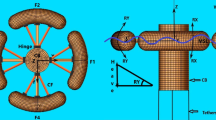Abstract
This paper is concerned with the issue of the efficiency of sea wave energy conversion. It is shown that the efficiency increases significantly if a low-damped mechanical oscillator, which is adapted to a wave power spectrum, is used as a primary converter. Two major types of oscillators are considered. The pendulum-type converter is found to be the most promising. A new schematic of a pendulum-type converter is suggested and briefly described. The converter consists of two oscillators adjusted to work in resonance mode. The first one includes a ballast-controlled floating platform pitching on sea waves. The second oscillator is a long sector-shaped pendulum located on the floating platform. The use of sea wave energy converters is promising in regard to the widespread use of renewable sources and elimination of the environmental impact of fossil fuel consumption in coastal regions. Various systems have been developed and projects implemented in this field.



Similar content being viewed by others
REFERENCES
Da Rosa, A., Fundamentals of Renewable Energy Processes, Amsterdam: Elsevier, 2005.
Panicker, N.N., Power resource potential of ocean surface waves, in Proceedings of the Wave and Salinity Gradient Workshop, Newark, Delaware,1976, pp. J1–J48.
Thorpe, T., Wave energy, in Survey of Energy Resources, World Energy Council, 2010, pp. 562–587.
Yemm R. Pelamis. / Cruz J, editor// Ocean wave energy. Berlin, Springer; 2008, pp. 304–321.
Crawford, F., Berkeley Physics Course, New York: McGraw-Hill, 1968.
Voytkunsky, Ya.I., Spravochnik po teorii korablya, Vol. 2. Statika sudov. Kachka sudov (Handbook of the Ship Theory, Vol. 2: Statics of Ships. Ship motions), Leningrad: Sudostroeniye, 1985.
Cheboxarov, V.V., Comparative analysis of the effectiveness of two schemes of pendulum wave energy converters, Energet. Ustanovki Tekhnol., 2016, vol. 2, no. 1, pp. 68–75.
Falnes, J., Ocean Waves and Oscillating Systems: Linear Interactions Including Wave-Energy Extraction, 2nd ed., Cambridge: Cambridge Univ. Press, 2002, p. 275.
Ruellan, M. et al., Design methodology for a searev wave energy converter, in Proceedings of the IEEE IEMDC Conference, Antalya, Turkey, 2007, pp. 1384–1389.
Budal, K. and Falnes, J., Interacting point absorbers with controlled motion, in Power from Sea Waves, Count, B.M., Ed., London: Academic, 1980, pp. 381–399.
Cheboxarov, V.V., On the creation of high power pendulum wave power plants, Energet. Ustanovki Tekhnol., 2016, vol. 2, no. 4, pp. 69–76.
Cheboxarov, V.V., Device for converting wave energy, RF Patent no. 2646523, Byull. Izobret., 2018, no. 7.
ACKNOWLEDGMENTS
We would like to thank our colleagues at the Nuclear Energy and Industry Institute, Sevastopol State University, for their continuous support.
Funding
This study was funded by the Ministry of Education and Science of the Russian Federation under an agreement with unique identifier RFMEFI57717X0275 and by a grant of Sevastopol State University.
Author information
Authors and Affiliations
Corresponding author
Additional information
Published as a matter for discussion
Translated by M. Chubarova
About this article
Cite this article
Cheboxarov, V.V., Yakimovich, B.A., Lyamina, N.V. et al. Some Results of a Study of Wave Energy Converters at Sevastopol State University. Appl. Sol. Energy 55, 256–259 (2019). https://doi.org/10.3103/S0003701X19040029
Received:
Revised:
Accepted:
Published:
Issue Date:
DOI: https://doi.org/10.3103/S0003701X19040029



